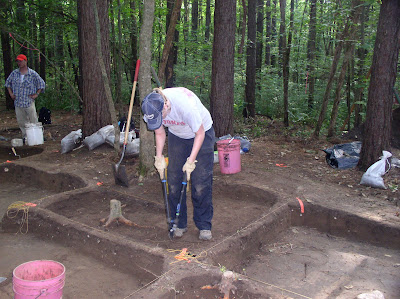Ahhh....The last day at the site. So bittersweet. We can't wait to get back home, but we are all a little sad to be leaving. All of the excavation is over, but now (cue dramatic music), begins the back filling. After 5 weeks of careful excavation, now we get to dump all of the dirt that came out of the units right back into them. Listen to me when I say, keep your dog, because a shovel is NOT your best friend.
 |
| Are you lookin' at me? |
Ok, backfilling goes a little something like this...shovel shovel shovel....dump. Shovel shovel shovel....dump. Some of us are really good at shoveling, and some are really good at dumping....but rarely does a shoveler dump or a dumper shovel, it's just the way it is.
 |
| A quick demonstration by Adam on how to properly hold up a shovel. Thanks Moody!!! |
While the dirt is being dumped back into the units, the spreader/stompers take care of business on their end...the dirt is spread throughout the unit and stomped down. Our goal is to leave the site as closely to the original condition as possible. Even though you can see where we excavated right now, within a few months, the forest will reclaim it and nobody will even know we were here.
 |
| That was NO slight of hand, those units disappeared!! |
Backfilling wasn't the only thing we were doing today...Eileen went with Dr. Livingood to collect topography stakes that were left during Total Station Mapping, Kevin went to collect all of the flagging tape that marked our trails, Bryce took down our makeshift bridge over muddy waters, and Amanda and crew took apart the tool bin we lovingly (or disturbingly) referred to as "the pine box". After all of these jobs were finished, everyone met at Block 1 and helped finish backfilling. The whole process took under two hours! Mainly because we are all so awesome. Just sayin'.
 |
| Els OWNED that site!!! (But what did that lunchbox ever do to her?) |
 |
| King of the Mountain....One of these days, all of this could be yours, kid. |
Once everything at the site was finished, we brought all of the excavation equipment back to camp, cleaned and oiled the tools, and repacked everything for the trip back. Once again, it's all bittersweet. We'll miss our friends, new and old, but we probably won't miss the snakes, ticks, mosquitoes, horseflies, wasps, spiders, humidity, 100 degree days, and the 6 o'clock mornings.
 |
| Tim D. The hardest working man outside of show biz. |
Goodbye McCurtain County. Hello Norman, ibuprofen, calamine lotion, air conditioning and sleeping in!!!
Michael Carlock, Eileen Schaumleffle, Justin Anderson, and Bridgett Kiefer.



















































